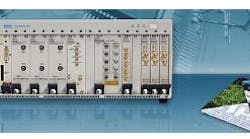PXI Vector Analyzer Tackles MIMO
Wide analysis bandwidth is an essential requirement for certain modern communications testers—notably, for systems based on multiple-input, multiple-output (MIMO) antennas. Unfortunately, conventional test tools like spectrum analyzers provide only limited analysis bandwidths. To create a solution for such challenges, Agilent Technologies (www.agilent.com) recently introduced a wideband MIMO PXI vector signal analyzer (VSA). Essentially a test system in the modular PXI format that is capable of providing an analysis bandwidth as wide as 780 MHz, it is ideal for evaluating new IEEE 802.11ac wideband wireless-local-area-network (WLAN) systems. The modular test system operates over a frequency range from 10 MHz to 26.5 GHz.
The PXI VSA (see figure) was just one of many test solutions from Agilent on display at the recent 2012 IEEE International Microwave Symposium (IMS) in Montreal, Canada. The PXI mainframe includes a model M9362A-D01 four-channel frequency downconverter module, one M9202A 12-b digitizer per channel, an M9302A local-oscillator (LO) module, an M9168C RF attenuator, and an M9352A intermediate-frequency (IF) amplifier/attenuator module.
This PXI-based modular test system provides four-channel vector signal analysis to 26.5 GHz across analysis bandwidths as wide as 780 MHz for MIMO testing.
The wideband four-channel VSA is made possible by the M9362A frequency downconverter module. It is based on the PXI Express (PXIe) backplane format. With a frequency range of 10 MHz to 26.5 GHz, the frequency downconverter can simultaneously translate four channels with instantaneous bandwidths as wide as 1.5 GHz. This makes it ideal for wideband signal capture. Frequency downconversion is performed with the aid of the model M9302A LO, a two-slot 3U PXI module that generates stable output signals at levels to +16 dBm from 3 to 10 GHz.
At RF/microwave frequencies, signal levels are controlled by the model M9168C programmable PXI step attenuator module. It provides an attenuation range of 0 to 101 dB in 1-dB steps from DC to 26.5 GHz with attenuation accuracy of ±0.4 dB at 26.5 GHz. The manufacturer quotes impressive 0.03-dB insertion-loss repeatability throughout each attenuation section for an operating lifetime of 5 million cycles. The insertion loss is only 2.5 dB through 6 GHz, 4.0 dB through 18 GHz, and 5.0 dB through 26.5 GHz.
Once signals have been downconverted to the IF range, they can be processed by the single-slot model M9352A four-channel PXI hybrid IF amplifier/attenuator. It has a frequency range of 10 MHz to 1 GHz, offering 31.5-dB attenuation in 0.5-dB steps and a 31.5-dB gain range in 0.5-dB steps. The unit is linear, with a third-order intercept point of +43 dBm, and features a low noise figure of 3 dB. Isolation between channels is better than 60 dB.
At that point, they are ready for conversion to the digital realm, achieved via the M9202A single-slot 12-b 3U PXIe digitizer. It features a 1-GHz-wide bandwidth (with 30-MHz nominal instantaneous bandwidth) and sampling rates to 2 GSamples/s. The digitizer is backed by 512-MB on-board memory and powered by a Virtex-6 field-programmable gate array (FPGA) from Xilinx (www.xilinx.com). It uses the PXIe backplane for fast data streaming and achieves a spurious-free dynamic range (SFDR) of typically −60 dBc with 9-b effective-number-of-bits (ENOB) performance.
The modules are housed within a model M9018A PXI/PXIe chassis and orchestrated under the command of a controller module. Working with Agilent’s 89600 VSA software and an additional display screen, the software-defined system provides flexible measurement capabilities—allowing for testing communications configurations as large as 4 x 4 MIMO systems.
Agilent Technologies, Inc.,5301 Stevens Creek Blvd., Santa Clara, CA 95051; (877) 424-4536, (408) 345-8886, FAX: (408) 345-8475, e-mail: [email protected],www.agilent.com.

